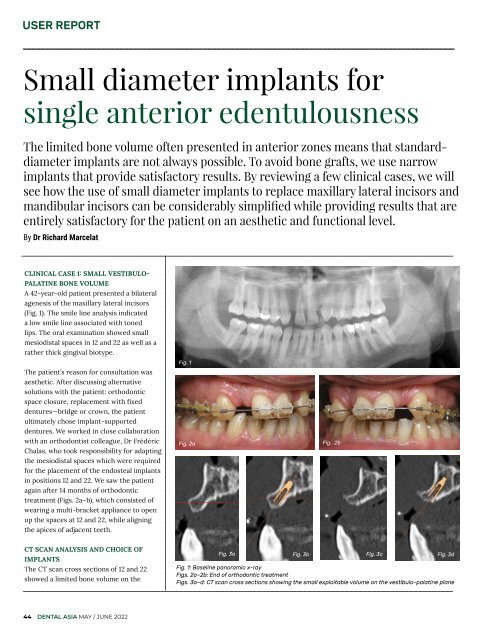Dental Asia May/June 2022
For more than two decades, Dental Asia is the premium journal in linking dental innovators and manufacturers to its rightful audience. We devote ourselves in showcasing the latest dental technology and share evidence-based clinical philosophies to serve as an educational platform to dental professionals. Our combined portfolio of print and digital media also allows us to reach a wider market and secure our position as the leading dental media in the Asia Pacific region while facilitating global interactions among our readers.
For more than two decades, Dental Asia is the premium journal in linking dental innovators and manufacturers to its rightful audience. We devote ourselves in showcasing the latest dental technology and share evidence-based clinical philosophies to serve as an educational platform to dental professionals. Our combined portfolio of print and digital media also allows us to reach a wider market and secure our position as the leading dental media in the Asia Pacific region while facilitating global interactions among our readers.
Create successful ePaper yourself
Turn your PDF publications into a flip-book with our unique Google optimized e-Paper software.
USER REPORT<br />
Small diameter implants for<br />
single anterior edentulousness<br />
The limited bone volume often presented in anterior zones means that standarddiameter<br />
implants are not always possible. To avoid bone grafts, we use narrow<br />
implants that provide satisfactory results. By reviewing a few clinical cases, we will<br />
see how the use of small diameter implants to replace maxillary lateral incisors and<br />
mandibular incisors can be considerably simplified while providing results that are<br />
entirely satisfactory for the patient on an aesthetic and functional level.<br />
By Dr Richard Marcelat<br />
CLINICAL CASE 1: SMALL VESTIBULO-<br />
PALATINE BONE VOLUME<br />
A 42-year-old patient presented a bilateral<br />
agenesis of the maxillary lateral incisors<br />
(Fig. 1). The smile line analysis indicated<br />
a low smile line associated with toned<br />
lips. The oral examination showed small<br />
mesiodistal spaces in 12 and 22 as well as a<br />
rather thick gingival biotype.<br />
The patient’s reason for consultation was<br />
aesthetic. After discussing alternative<br />
solutions with the patient: orthodontic<br />
space closure, replacement with fixed<br />
dentures—bridge or crown, the patient<br />
ultimately chose implant-supported<br />
dentures. We worked in close collaboration<br />
with an orthodontist colleague, Dr Frédéric<br />
Chalas, who took responsibility for adapting<br />
the mesiodistal spaces which were required<br />
for the placement of the endosteal implants<br />
in positions 12 and 22. We saw the patient<br />
again after 14 months of orthodontic<br />
treatment (Figs. 2a–b), which consisted of<br />
wearing a multi-bracket appliance to open<br />
up the spaces at 12 and 22, while aligning<br />
the apices of adjacent teeth.<br />
Fig. 1<br />
Fig. 2a<br />
Fig. 2b<br />
CT SCAN ANALYSIS AND CHOICE OF<br />
IMPLANTS<br />
The CT scan cross sections of 12 and 22<br />
showed a limited bone volume on the<br />
Fig. 3a Fig. 3b Fig. 3c Fig. 3d<br />
Fig. 1: Baseline panoramic x-ray<br />
Figs. 2a–2b: End of orthodontic treatment<br />
Figs. 3a–d: CT scan cross sections showing the small exploitable volume on the vestibulo-palatine plane<br />
44 DENTAL ASIA MAY / JUNE <strong>2022</strong>


















